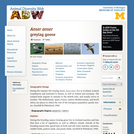
Anser anser: Information
- Subject:
- Life Science
- Zoology
- Material Type:
- Reading
- Provider:
- University of Michigan Museum of Zoology
- Provider Set:
- Animal Diversity Web
- Author:
- Saul Vargas (author), Fresno City College
- Date Added:
- 03/07/2005

Anser anser: Information
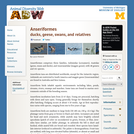
Anseriformes: Information
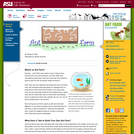
Farming ants might sound like a crazy thing to do unless you might like to eat chocolate covered ants. It turns out we can learn a lot from ants and the best way is to build your own ant farm.
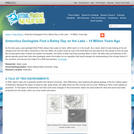
This article describes a discovery of moss and ostracod fossils that led to a better understanding of Antarctica's climate history.

This informational text explains that while both the Arctic and Antarctica are cold, Antarctica is much colder and drier - a polar desert. The text is written at a grade two through grade three reading level. This version is a full-color PDF that can be printed, cut and folded to form a book. Each book contains color photographs and illustrations.
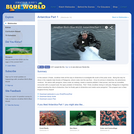
In this video, Jonathan treks all the way to Antarctica to investigate life south of the polar circle. Along the way he dives in the majestic kelp forests of Patagonia, where crabs rule the sea floor. Once he arrives in Antarctica, his adventures continue. He swims with penguins, dives under an iceberg, meets a massive jellyfish 3 feet wide, and has an incredible encounter with a Leopard seal, the apex predator of Antarctica. Part 1 finds Jonathan diving in Ushuaia, Patagonia in Argentina before boarding the ship to Antarctica, then he finally gets to Antarctica and meets some penguins! This program won a New England Emmy Award! Please see the accompanying lesson plan for educational objectives, discussion points and classroom activities.
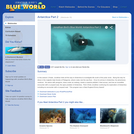
In this video, Jonathan treks all the way to Antarctica to investigate life south of the polar circle. Along the way he dives in the majestic kelp forests of Patagonia, where crabs rule the sea floor. Once he arrives in Antarctica, his adventures continue. He swims with penguins, dives under an iceberg, meets a massive jellyfish 3 feet across, and has an incredible encounter with a Leopard seal, the apex predator of Antarctica. Part 2 finds Jonathan continuing his exploration of Antarctica including an encounter with a Leopard seal. This program won a New England Emmy Award! Please see the accompanying lesson plan for educational objectives, discussion points and classroom activities.
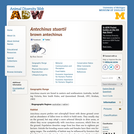
Antechinus stuartii: Information
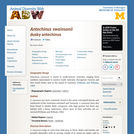
Antechinus swainsonii: Information
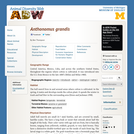
Anthonomus grandis: Information
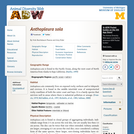
Anthopleura elegantissima: Information

Anthopleura xanthogrammica: Information
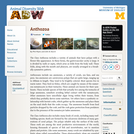
Anthozoa: Information
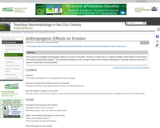
This exercise focuses on anthropogenic effects on erosion. It could be run as a single lab or as a series of in-class exercises or problem sets. We discussed an article by Hooke and used it as a launching pad for a discussion of back of the envelope calculations. Students then estimate the volume moved by mountain-top removal and how long it might take a river to mobilize that sediment. They estimate the cost for beach nourishment along Florida beaches. They estimate the contribution of local construction projects and road gravel to stream sediment loads. This activity gives students a chance to formulate a problem, make simple measurements, estimate unknowns, and calculate volumes, rates, and costs of various human earth-moving activities.
Designed for a geomorphology course
Addresses student fear of quantitative aspect and/or inadequate quantitative skills
Uses geomorphology to solve problems in other fields
(Note: this resource was added to OER Commons as part of a batch upload of over 2,200 records. If you notice an issue with the quality of the metadata, please let us know by using the 'report' button and we will flag it for consideration.)
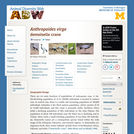
Anthropoides virgo: Information
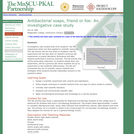
This lab activity will not only draw on students' real life experiences but will also draw on student's previous lab experiences in proper laboratory techniques and data analysis performed in previous activities. The lab will incorporate the use of scientific inquiry methods and strategies while students develop reasonable answers to the questions asked.

One of the greatest challenges of 21st century is Antibiotic Resistance(AR). Unless urgent measures are taken it could take epidemic proportions and lead to a situation where even common infections could become fatal due to ineffectiveness of antibiotics and unavailibility of alternative therapies.go through this to have a basic understanding 1antibiotic resistance can spread via food and food chain also , for example sprouts and chicken meat- ar
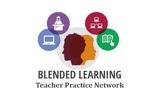
Antibiotics save people’s lives...and make bacteria stronger and more likely to kill us. What is the best practice to balance these conflicting issues? In this problem-based learning module, the students will be evaluating real-life medical situations in conjunction with actual staff at those institutions and offering action plans to be ‘implemented’ there. In order to accomplish this, the science unit will be interlocking with social studies and a language arts unit that will have them identifying target audiences and sculpting a way to present their findings. This unit has the potential to be a full problem-based unit as well as highly interdisciplinary--it’s connected to full units in social studies and language arts which stand alone but can be fully integrated if desired.
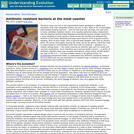
The pork chops you buy in the supermarket neatly packaged in plastic and styrofoam may look completely sterile, but are, in fact, likely to be contaminated with disease-causing bacteria - and not with just any old bugs, but with hard-to-treat, antibiotic resistant strains. In a recently published study, researchers with the National Antimicrobial Resistance Monitoring System bought meat from a wide sampling of chain grocery stores across the country and analyzed the bacteria on the meat. Resistant microbes were found in 81% of ground turkey samples, 69% of pork chops, 55% of ground beef samples, and 39% of chicken parts.

This resource is a video abstract of a research paper created by Research Square on behalf of its authors. It provides a synopsis that's easy to understand, and can be used to introduce the topics it covers to students, researchers, and the general public. The video's transcript is also provided in full, with a portion provided below for preview:
"Human gut microbes are critical for maintaining the integrity of the GI tract, immune system homeostasis, and host energy metabolism. Alterations in this network can have health consequences, including inflammatory bowel disease (IBD). Antibiotic treatment compromises the composition of the gut microbiome, affecting microbial function and resulting in long-lasting detrimental effects on the host. A recent study examined how different antibiotics affect the ability of gut microbes to control intestinal inflammation. Researchers treated mice with antibiotics prior to fecal microbiota transplantation. They found that antibiotic pre-treatment significantly altered the ability of the microbiota to control intestinal inflammation. Streptomycin- and vancomycin-treated microbes failed to control inflammation, and pathobionts associated with IBD thrived. In contrast, microbes treated with metronidazole were able to control inflammation, and beneficial microbial species were enriched..."
The rest of the transcript, along with a link to the research itself, is available on the resource itself.